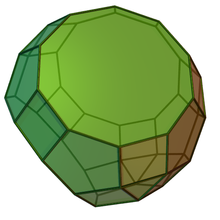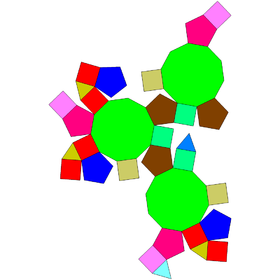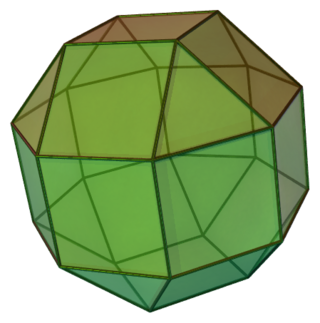
In geometry, a Johnson solid is a strictly convex polyhedron each face of which is a regular polygon. There is no requirement that each face must be the same polygon, or that the same polygons join around each vertex. An example of a Johnson solid is the square-based pyramid with equilateral sides ; it has 1 square face and 4 triangular faces. Some authors require that the solid not be uniform before they refer to it as a "Johnson solid".

In geometry, the rhombicosidodecahedron is an Archimedean solid, one of thirteen convex isogonal nonprismatic solids constructed of two or more types of regular polygon faces.

In geometry, the tridiminished icosahedron is one of the Johnson solids. The name refers to one way of constructing it, by removing three pentagonal pyramids from a regular icosahedron, which replaces three sets of five triangular faces from the icosahedron with three mutually adjacent pentagonal faces.

In geometry, the square orthobicupola is one of the Johnson solids. As the name suggests, it can be constructed by joining two square cupolae along their octagonal bases, matching like faces. A 45-degree rotation of one cupola before the joining yields a square gyrobicupola.

In geometry, the pentagonal cupola is one of the Johnson solids. It can be obtained as a slice of the rhombicosidodecahedron. The pentagonal cupola consists of 5 equilateral triangles, 5 squares, 1 pentagon, and 1 decagon.

In geometry, the diminished rhombicosidodecahedron is one of the Johnson solids. It can be constructed as a rhombicosidodecahedron with one pentagonal cupola removed.

In geometry, the gyrate rhombicosidodecahedron is one of the Johnson solids. It is also a canonical polyhedron.

In geometry, the parabidiminished rhombicosidodecahedron is one of the Johnson solids. It is also a canonical polyhedron.

In geometry, the metabidiminished rhombicosidodecahedron is one of the Johnson solids.

In geometry, the trigyrate rhombicosidodecahedron is one of the Johnson solids. It contains 20 triangles, 30 squares and 12 pentagons. It is also a canonical polyhedron.

In geometry, the pentagonal gyrobicupola is one of the Johnson solids. Like the pentagonal orthobicupola, it can be obtained by joining two pentagonal cupolae along their bases. The difference is that in this solid, the two halves are rotated 36 degrees with respect to one another.

In geometry, the parabigyrate rhombicosidodecahedron is one of the Johnson solids. It can be constructed as a rhombicosidodecahedron with two opposing pentagonal cupolae rotated through 36 degrees. It is also a canonical polyhedron.

In geometry, the paragyrate diminished rhombicosidodecahedron is one of the Johnson solids. It can be constructed as a rhombicosidodecahedron with one pentagonal cupola rotated through 36 degrees, and the opposing pentagonal cupola removed.
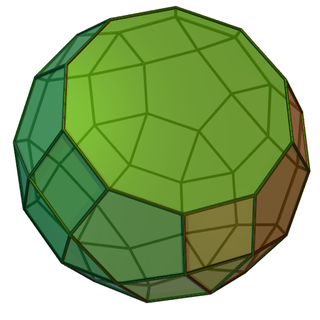
In geometry, the metagyrate diminished rhombicosidodecahedron is one of the Johnson solids. It can be constructed as a rhombicosidodecahedron with one pentagonal cupola rotated through 36 degrees, and a non-opposing pentagonal cupola removed.

In geometry, the bigyrate diminished rhombicosidodecahedron is one of the Johnson solids. It can be constructed as a rhombicosidodecahedron with two pentagonal cupolae rotated through 36 degrees, and a third pentagonal cupola removed.
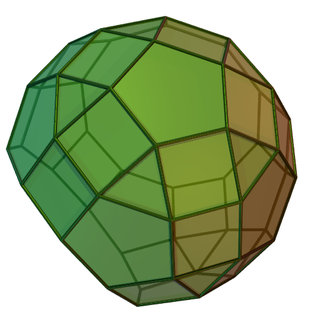
In geometry, the gyrate bidiminished rhombicosidodecahedron is one of the Johnson solids.
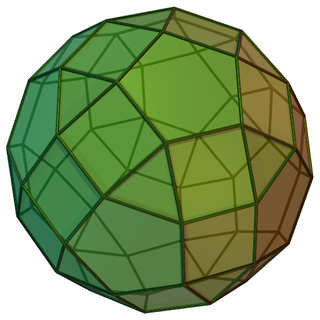
In geometry, the metabigyrate rhombicosidodecahedron is one of the Johnson solids. It can be constructed as a rhombicosidodecahedron with two non-opposing pentagonal cupolae rotated through 36 degrees. It is also a canonical polyhedron.
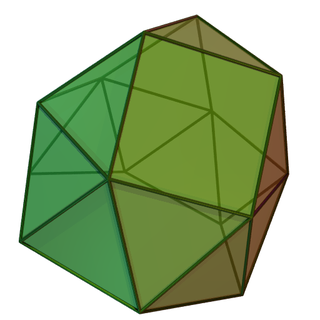
In geometry, the gyroelongated triangular cupola is one of the Johnson solids (J22). It can be constructed by attaching a hexagonal antiprism to the base of a triangular cupola (J3). This is called "gyroelongation", which means that an antiprism is joined to the base of a solid, or between the bases of more than one solid.
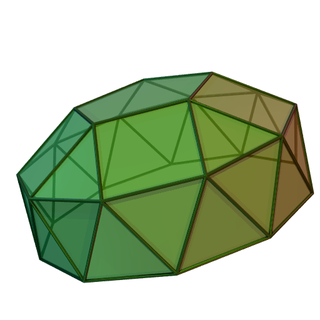
In geometry, the gyroelongated cupolae are an infinite set of polyhedra, constructed by adjoining an n-gonal cupola to an 2n-gonal antiprism.
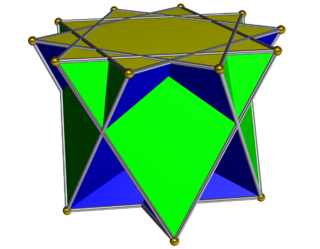
In geometry, the crossed pentagrammic cupola is one of the nonconvex Johnson solid isomorphs, being topologically identical to the convex pentagonal cupola. It can be obtained as a slice of the great rhombicosidodecahedron or quasirhombicosidodecahedron. As in all cupolae, the base polygon has twice as many edges and vertices as the top; in this case the base polygon is a decagram.
This page is based on this
Wikipedia article Text is available under the
CC BY-SA 4.0 license; additional terms may apply.
Images, videos and audio are available under their respective licenses.
